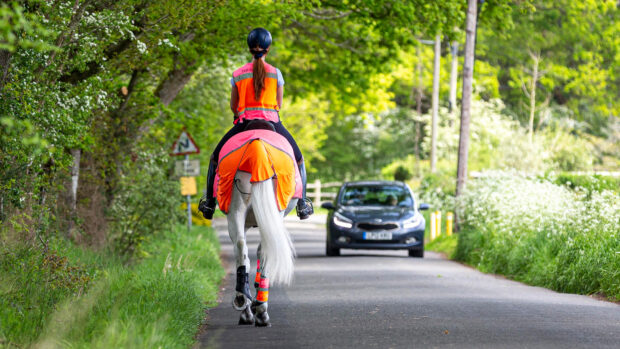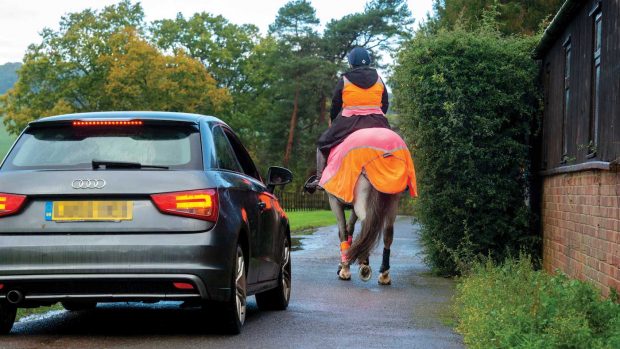H&H’s website editor writes an open letter to non-horsey drivers to help them understand the risks of passing horses without due care
One of the most common situations where those unfamiliar with horses are likely to encounter an equine is while out driving in their car.
While riders would genuinely love to exercise their horses in farmers’ fields, very few farmers allow this, leaving us no option but to ride on roads in order to access bridleways and byways where we can ride without worrying about the dangers of other road users. (NB: horses are not allowed on footpaths).
So as there is a chance that you might encounter a horse and rider while out and about, there are some typical patterns of equine behaviour that I’d like to take a moment to explain, which are particularly relevant when a vehicle and a horse meet on the road.
Firstly, the flight response (if in doubt, horses like to run away first and ask questions later) remains alive and well in all horses, despite thousands of years of domestication and extensive training. Another key equine instinct is safety in numbers, brought about by the fact horses evolved to live in herds.
So in a nutshell, horses are easily scared and they like each other’s company.
This helps to explain why, while out riding with another horse and rider on the roads, one horse may decide that the lorry/motorbike/car advancing at speed is a major cause for concern, while its companion may be far more worried about the strange coloured plant growing in the verge.
In such a situation, the first horse may attempt to turn tail and run from the vehicle, potentially straight into the path of another road user, while the second is equally likely to shoot out in front of the first vehicle, in order to prevent potential attack from the harmless leaf. Then, when spotting its companion legging it down the road, the second horse is quite likely to attempt to join him as the herd instinct kicks in.
With horses’ ability to shoot sideways at high speed in a millisecond, even the best riders can find themselves momentarily foxed in such a situation, as they try to control their mount. This is not an experience we enjoy and if we can see a situation ahead that might lead to this, we may use hand signals to ask you to slow down or stop in order to avoid it happening.
Riders can see and hear much more of their surroundings than you can from inside your car, so please do act on such requests, even if the road ahead appears clear. The rider may well have spotted a noisy dog in a garden, heard something the other side of a hedge or seen something else that they know risks their horse taking evasive action that would take its body into your car’s trajectory.
Another cause for consternation among drivers, is when they come across a pair of horses being ridden side by side, who do not return to single file when they approach. This is typically not because their riders want to continue to enjoy a good chin wag, but because the horse or rider on the inside is inexperienced. By placing the more experienced horse and/or rider closer to the white line in the middle of the road, they can shield the inexperienced one from passing traffic and also encourage the inside horse to stay on the straight and narrow, rather than sitting on the bonnet of your car when they spot the aforementioned funny coloured leaf in the verge.
So what should you do if you do come across a horse and rider on the roads? The best advice I can offer is to slow down (no, slower than that – about 15mph is ideal – yes I know that’s feels really slow, but it’s potentially your car and your life that could be at stake, as well as the life of the horse and rider – we don’t dent, we die) and pass leaving at least 2 metres between your vehicle and the horse.
Article continues below…
You might also be interested in:

Wheelie bins eat horses — and other things you need to know before you go hacking
Sharing your hacking routes with other road users can be challenging. Here's six things you absolutely need to know before
Should you see the rider start waving their hands around while looking a little red in the face, or stare at you with an ashen look and white knuckles as they maintain a death grip on the reins, it may be wise to stop and allow the horse to pass your vehicle instead of the other way around. It may take a little more time out of your day, but horses can make a very big dent in your car’s bonnet and you really don’t want to see what damage they can do to your windscreen should a collision occur. Oh yes, and as I said before: we don’t dent, we die. Would you want that on your conscience?
The vast majority of horse riders don’t want to exercise their horses on the roads, but with incredibly limited off-road riding available, we have no choice. And whether you think we should be there or not, we do have a legal right to be. So please take a moment to slow down and pass wide when you next meet a horse and you’re likely to get a big smile and a wave from the rider for your courtesy. It will only take a couple of extra seconds to slow down. We all have a right to use the roads, so let’s make it a good experience for everyone.
For all the latest news analysis, competition reports, interviews, features and much more, don’t miss Horse & Hound magazine, on sale every Thursday.




